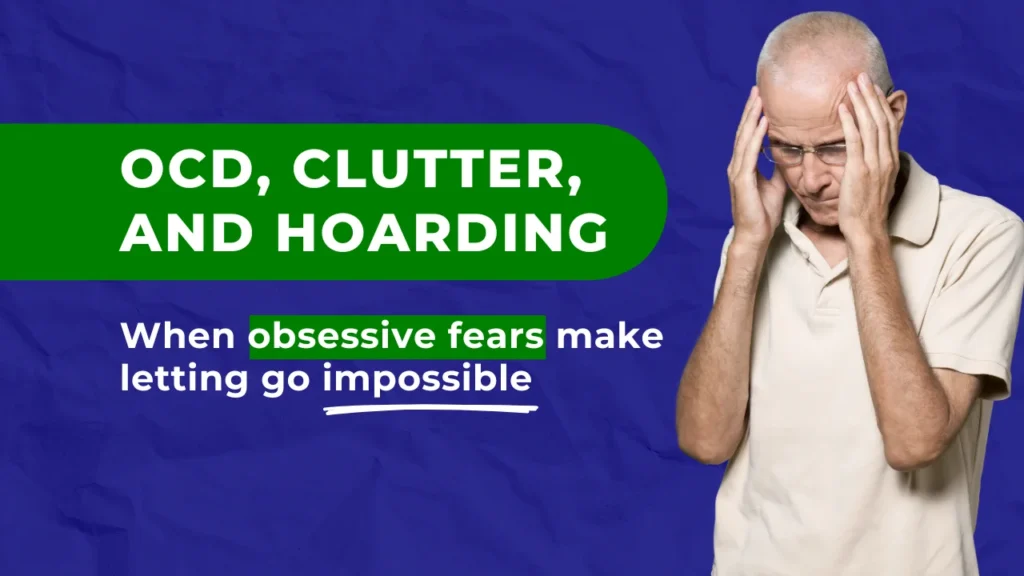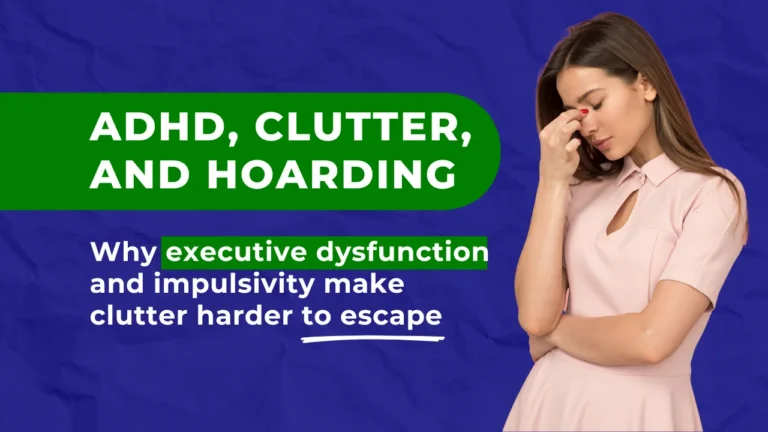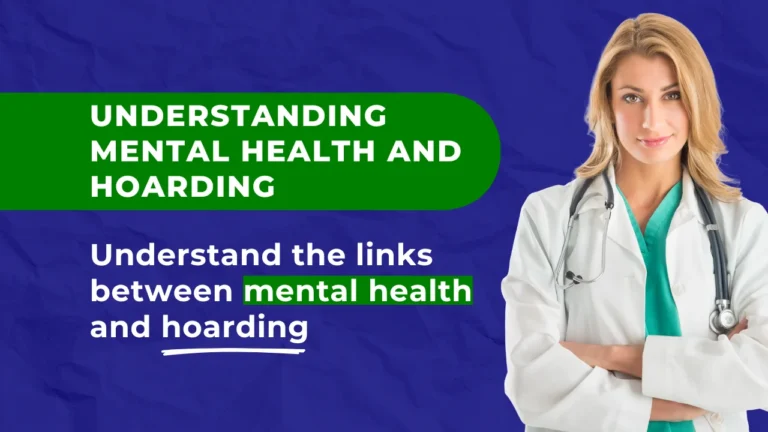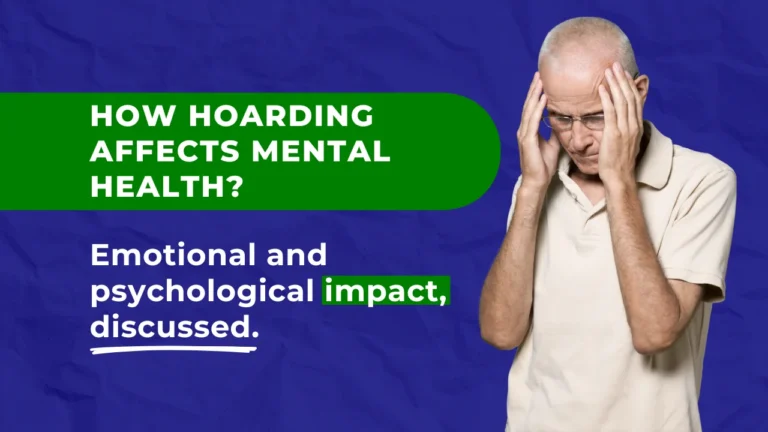OCD and hoarding goes something like this: Imagine someone standing in their kitchen, holding a broken remote or an old receipt. It’s not that they forgot to throw it out. It’s not laziness. There’s a knot in their chest, a thought in their head whispering, “If I toss this, something bad might happen.”
So they set it down again. And that’s how it stays for weeks, months, maybe years.
Obsessive-compulsive disorder, or OCD, doesn’t always show up the way people think. It’s not always just handwashing or counting or keeping things tidy.
In fact, for some, it can look like clutter. Piles of objects. Rooms so full, you can barely step inside. When OCD fuels mental health and hoarding behavior, the reasons behind the mess are complex and deeply tied to fear, obsession, and ritual.
What Is OCD? (In Real Terms)
At its core, OCD is a pattern of obsessive thoughts and compulsive behaviors. Obsessions are unwanted, intrusive thoughts that cause distress. Compulsions are the things a person does, mentally or physically, to try to feel better, safer, or more in control.
OCD often centers around themes: fear of contamination, the need for things to feel “just right,” or a dread that harm will come to someone if a certain rule isn’t followed. It’s not about being quirky or overly neat. It’s about anxiety that hijacks a person’s thinking and pushes them to act in ways that, on the surface, may not make sense to others.

These obsessions and compulsions aren’t always visible. Sometimes, they play out quietly; especially in the home, where routines around saving, arranging, or avoiding can turn into long-term clutter.
How OCD and Hoarding Become Connected
Not everyone with OCD hoards, and not everyone who hoards has OCD. But when OCD and hoarding overlap, the clutter isn’t random. It’s part of a system built around fear and relief. Here’s how that can unfold:
Fear-Based Decision Making

Someone with OCD may truly believe that getting rid of an object could trigger something terrible. Think sickness, misfortune, or guilt. An empty cereal box might seem meaningless to most, but for them, it could feel like a protective item, something that’s been “keeping bad things at bay.” Letting it go feels dangerous.
Intrusive Thoughts
These are those looping, distressing thoughts that don’t go away. “What if I need this later?” “What if this is the only proof I have?” These questions can get stuck on repeat, and the easiest way to quiet them is to keep the item. This cycle of obsessive thoughts and saving reinforces the anxiety, making it harder to part with even simple objects. Over time, those saved items stack up.
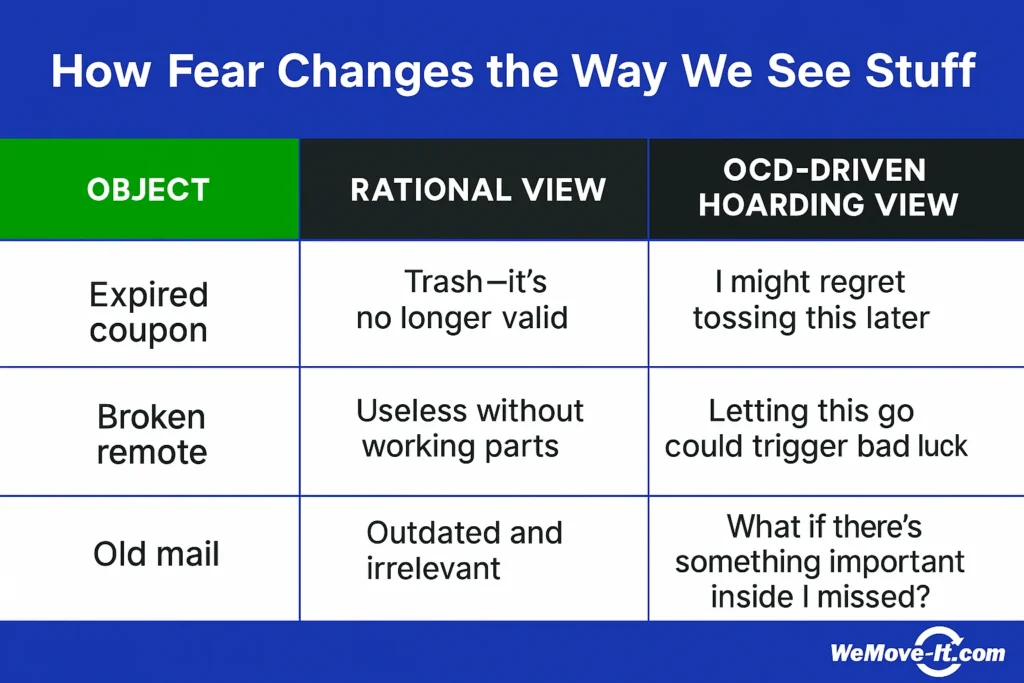
Rituals Around Possessions
Objects aren’t always just kept, they’re arranged, counted, or touched in certain ways. The behavior becomes a form of relief, a ritual that gives temporary calm. Over time, these routines can turn into hoarding compulsions, where the act of keeping or arranging things starts to feel mandatory.
According to Anxiety Canada, between 80% and 90% of individuals with hoarding disorder engage in excessive acquisition, whether through buying, collecting, or even taking items others consider trash. This constant inflow adds to the clutter, making the idea of decluttering even more overwhelming.

Avoidance
When every item feels loaded with meaning, or potential danger, decision-making becomes exhausting. So it gets put off. Then put off again. The backlog builds, and before long, we’re no longer only saving things, but too overwhelmed to face it at all.
OCD and Hoarding vs. Classic Hoarding Disorder
One of the biggest misconceptions is that all hoarding is the same. But the root cause matters.
Hoarding disorder is often tied to emotional attachment or a general difficulty with discarding items. It may stem from trauma, loss, or a need for control, but the driving force isn’t usually fear of harm.
With OCD, the clutter comes from a different place. It’s tied directly to intrusive thoughts and specific rituals. The person may not feel emotionally attached to the items. Instead, they’re afraid of what could happen if they let them go.
That said, it’s possible for someone to have both OCD and hoarding disorder. The overlap can make things even more complicated and that’s why diagnosis and treatment should always come from a qualified mental health professional, not just assumptions based on appearance. There are also other personality disorders that can influence hoarding behaviour, and knowing the difference can help shape better support.
Supporting Someone with OCD-Driven Hoarding
If you’re trying to help someone who’s struggling with this, know that force and judgment won’t get you far. The clutter is tied to fear, belief systems, and rituals that feel necessary to the person living in them.
Try to start with empathy. Don’t barge in and start tossing things. That might feel like progress to you, but to someone with OCD, it can be deeply traumatic.

Instead, build trust. Ask questions gently. Offer to sit with them while they consider letting go with OCD: starting with just one item, not ten. Small steps matter more than big gestures. Encourage them to connect with a mental health professional, especially one who understands OCD. Treatments like Cognitive Behavioral Therapy (CBT) and Exposure and Response Prevention (ERP) can make a real difference.
If cleanup help is needed, make sure it’s done with care and understanding. A respectful approach, one that works with the person, not against them, is key. If you’re living with someone who struggles in this way, it’s worth understanding the emotional toll of living with a hoarder, especially when mental health challenges like OCD are involved.
When It’s Time to Ask for Help
If the clutter has reached a point where it’s unsafe, unlivable, or clearly tied to obsessive thoughts, it might be time to bring in outside support. At WeMove-It.com, we understand how OCD and hoarding can shape a person’s relationship with their belongings. Our team provides hoarding services and works with families in Hamilton and surrounding areas to clean up without judgment, always with care, respect, and a deep awareness of what those items might represent.
Because sometimes, letting go isn’t simple. And that’s okay.
